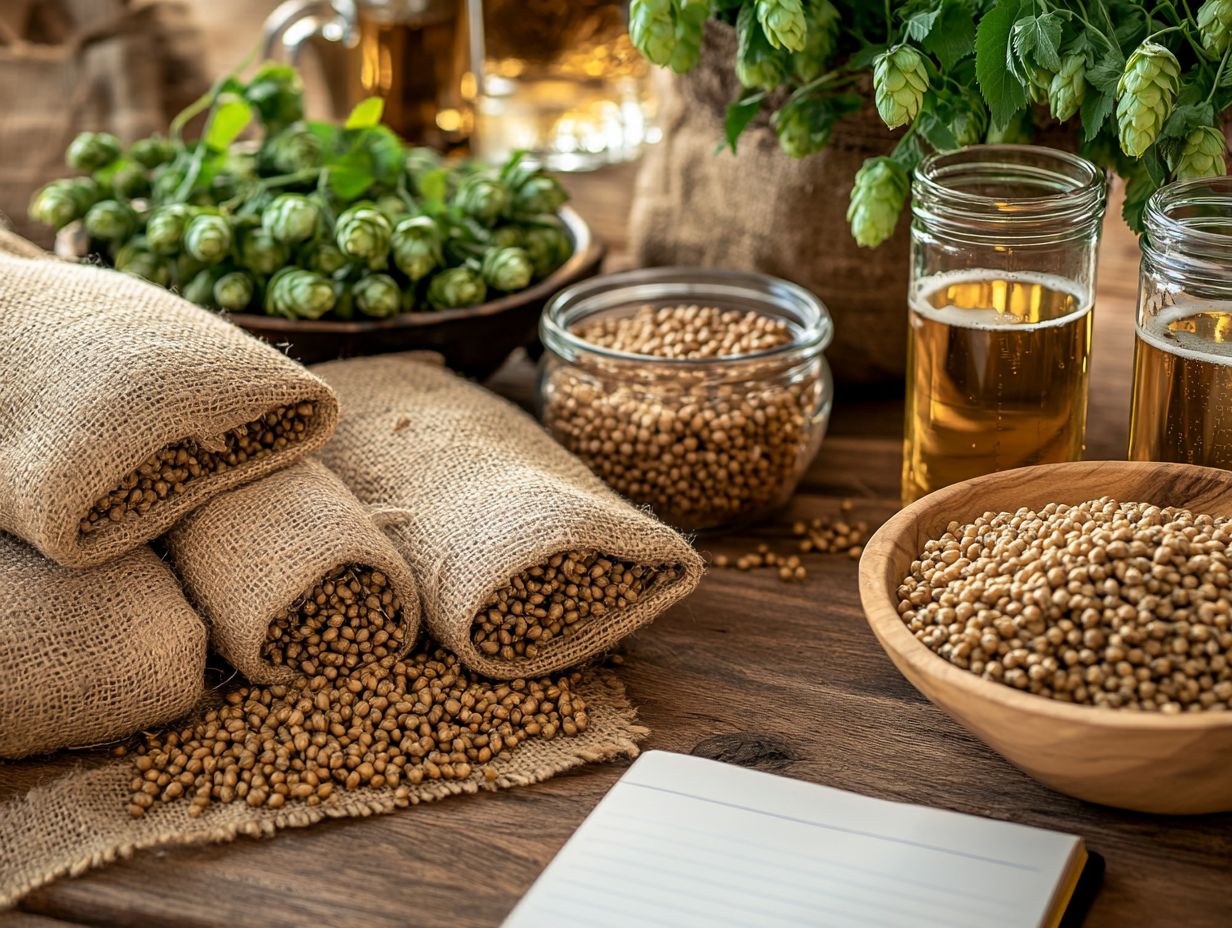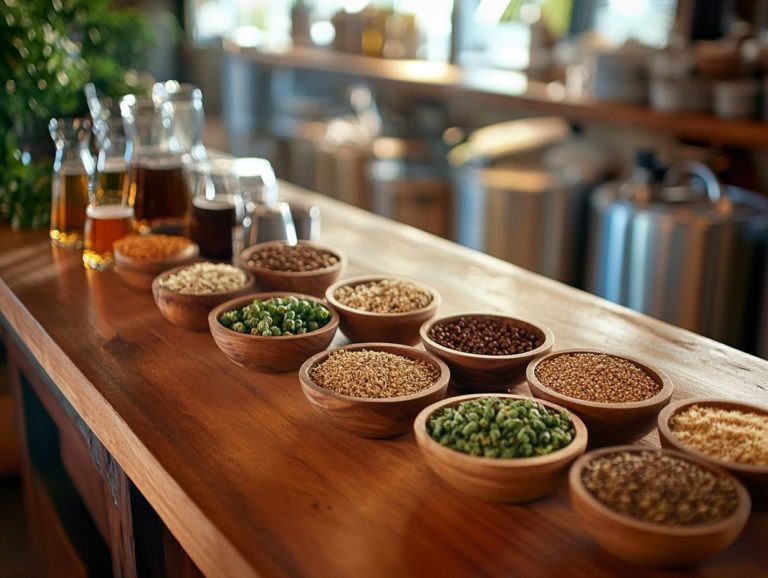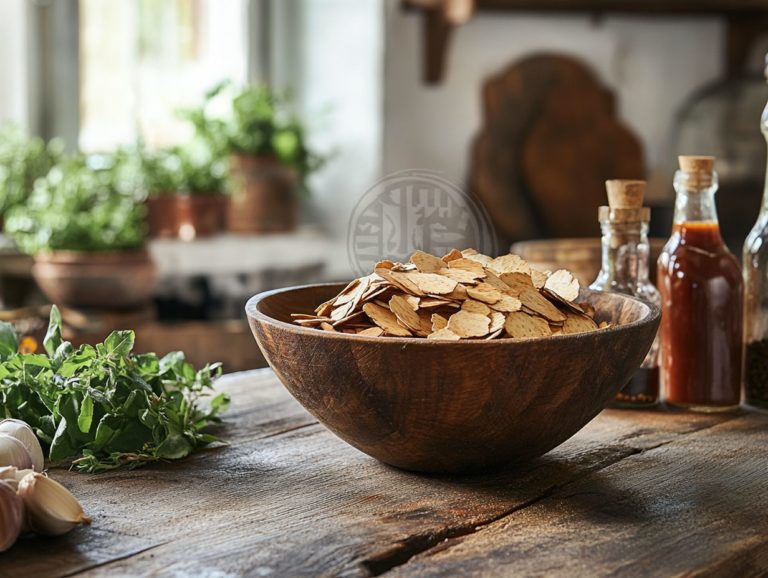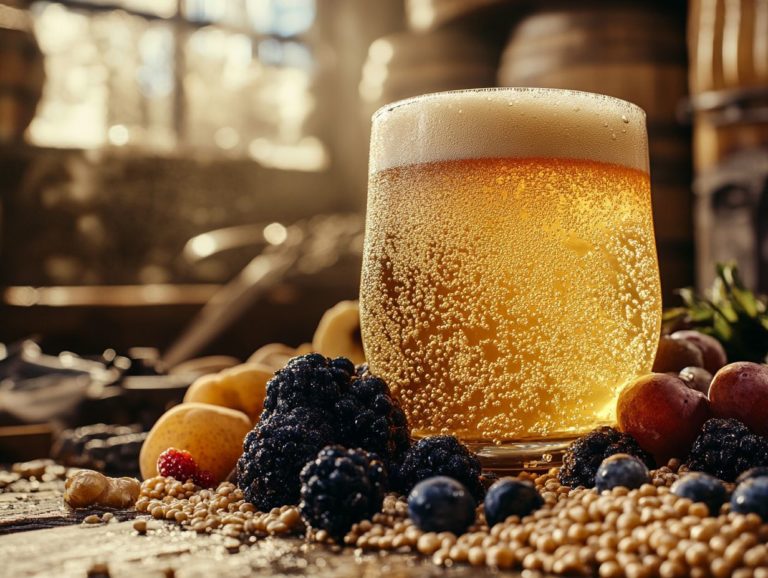5 Key Factors for Selecting Beer Ingredients
Selecting the right ingredients is essential in your quest to craft the perfect beer. Every choice you make, from the type of beer you wish to brew to the availability and cost of ingredients like malt, hops, yeast, and water, plays a significant role in shaping the flavor profile and overall quality of your final creation.
Consider five pivotal factors when choosing your beer ingredients, including how various components influence taste, mouthfeel, color, and the exciting opportunities to experiment with local or unique options like fruit puree and essential oils.
Immerse yourself in the art and science of brewing exceptional beer, considering the intricate brewing process that involves grains, hops, yeast, and water.
Contents
- Key Takeaways:
- 1. Type of Beer Being Brewed: Ales vs. Lagers
- 2. Availability of Brewing Ingredients
- 3. Crafting Your Desired Flavor Profile
- 4. Key Considerations for Ingredient Costs
- 5. The Brewing Process and Equipment
- How Do Different Ingredients Affect Beer Taste?
- Frequently Asked Questions
- Understanding Beer Ingredient Selection
Key Takeaways:
1. Type of Beer Being Brewed: Ales vs. Lagers
The type of beer you choose to brew is paramount to the entire brewing process. It dictates the selection of ingredients, flavors, and techniques, ultimately shaping the beer’s unique personality and character. From the rich, complex notes of ales to the crisp, refreshing qualities of lagers, each beer style presents a distinct combination of grains, hops, and yeast strains that contribute to its flavor profile, aroma, and aromatic characteristics. Thus, your choice of beer type is a fundamental consideration in your journey as a brewing artist within the vibrant craft beer industry.
Ales, for instance, are fermented at warmer temperatures, often boasting fruity and robust flavors that are perfect for those seeking a fuller taste experience. In contrast, lagers undergo a cooler fermentation process, resulting in a cleaner and smoother finish that appeals to a broader audience.
Microbreweries are pivotal in this landscape, experimenting with various brewing techniques and ingredients to create unique variations of these styles. Their passion and creativity yield a diverse range of offerings that highlight different methods and local influences, inviting you to explore and savor each distinct creation.
2. Availability of Brewing Ingredients
The availability of high-quality brewing ingredients is a crucial consideration for you as a brewer, directly influencing both your brewing process and the final quality of your product. Essential components like grains, hops, yeast, and brewing water must be sourced with care, ensuring each meets the necessary standards for crafting exceptional beer. This availability can be affected by factors such as seasonal variations and the reliability of suppliers.
Locality, seasonal variations, and supplier reliability are all factors that can impact the availability of these ingredients, prompting you to adapt your recipes and brewing techniques to create the distinct flavors, aromas, and stability that define your craft beer.
Utilizing local ingredients not only enhances the uniqueness of your brew but also supports regional agriculture and promotes sustainability. By prioritizing local sourcing, you can reduce your carbon footprint and contribute to a more resilient food system, all while ensuring the freshness and quality of ingredients like barley and hops.
However, challenges such as ingredient scarcity can emerge, especially when certain crops face environmental stress. To navigate these hurdles, you can cultivate strong relationships with farmers, explore alternative grains or hops, and collaborate on innovative growing methods. This proactive approach ensures you maintain a consistent supply of quality ingredients like malted barley, hops, and yeast strains while successfully adapting to the unpredictable nature of farming.
3. Crafting Your Desired Flavor Profile
Determining your desired flavor profile is essential in the brewing process, as it shapes your selection of ingredients, brewing techniques, and fermentation methods. A well-balanced beer artfully combines sweetness, bitterness, and other elements such as mouthfeel, color, and aroma to create a sensory experience that truly delights the palate.
As a craft brewer, you have the opportunity to experiment with various flavor combinations, leveraging the unique characteristics of different malt flavors, diverse hop varieties, and intriguing additives like fruit purees or essential oils. This creativity allows you to develop a distinct beer that captivates enthusiasts and showcases your brewing artistry, incorporating both the science and art of brewing.
These elements allow you to craft various beer styles, from the crisp and refreshing Pilsner to the rich and complex Imperial Stout, each requiring a unique approach to achieve its signature characteristics. For example, a fruity American Pale Ale may balance the bitterness of hops with the sweetness of specific malts while incorporating bright citrus flavors from Citra or Amarillo hops. Experimenting with different yeast strains can further enhance the complexity of these styles.
Experimenting with barrel aging introduces deep flavors, such as oak or vanilla, further enhancing complexity.
Your innovation and exploration of diverse flavors can redefine what beer can be!
4. Key Considerations for Ingredient Costs
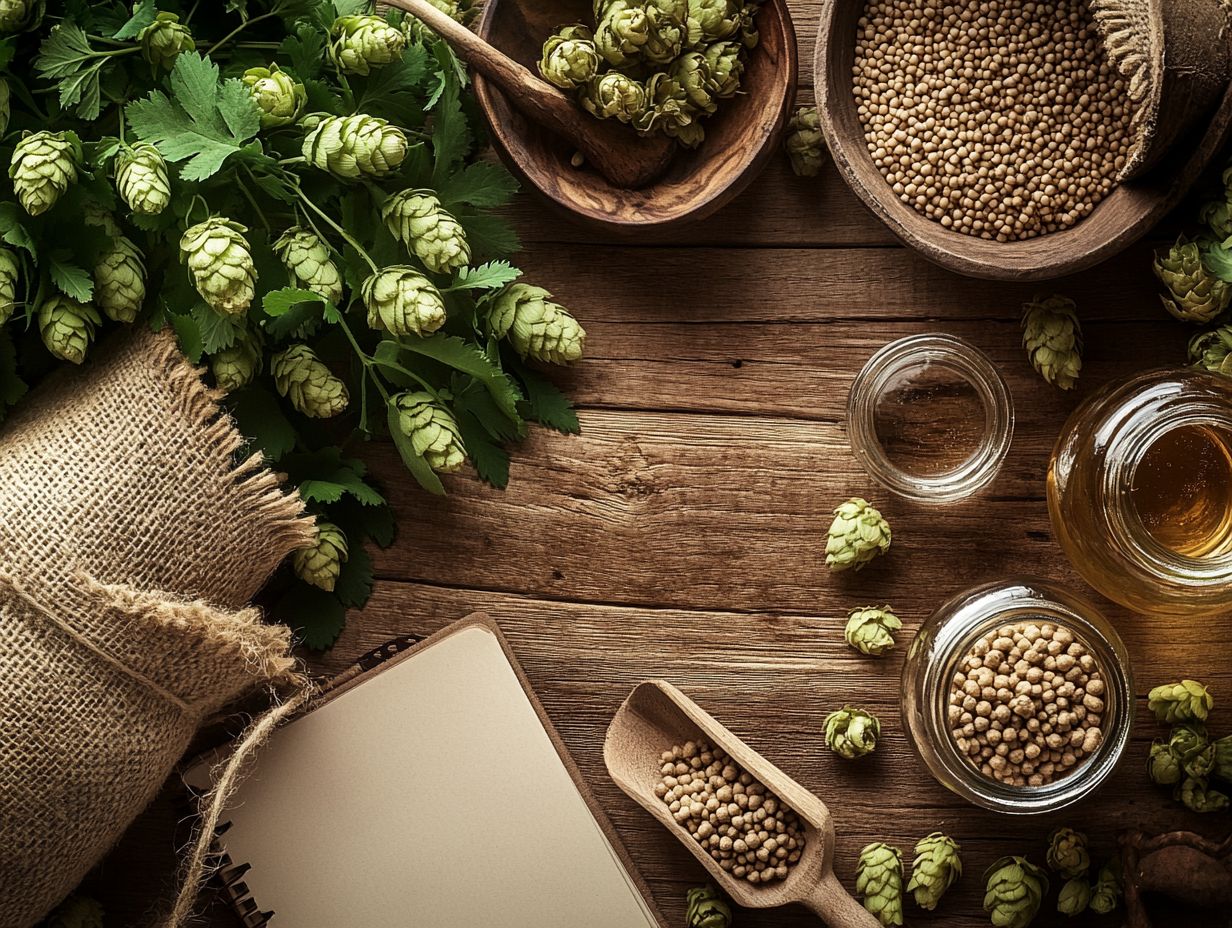
The cost of ingredients is a pivotal factor in your brewing process, shaping both your overall budget and pricing strategy as a microbrewery. The prices of high-quality ingredients think malt, hops, yeast, and brewing water can fluctuate based on sourcing, seasonal availability, and production methods. This variability demands that you plan your finances wisely to stay ahead!
By gaining a solid understanding of the market and strategically selecting your ingredients, you can optimize costs while still delivering exceptional craft beer that not only meets consumer expectations but also reflects your unique brewing vision.
Navigating the ever-changing prices of these essential components requires a sharp awareness of market trends and potential supplier relationships. Analyzing local and global supply chains can uncover opportunities for cost savings, especially through bulk purchasing agreements or direct partnerships with farmers and producers.
For small-batch brewers like yourself, who often operate on tighter margins, adopting local sourcing strategies can greatly reduce transportation costs while fostering community support and ensuring the freshest ingredients. Such approaches can significantly enhance your ability to maintain quality while managing expenses, allowing you to focus on creating innovative recipes that carve out a niche in a competitive market. Techniques like SMASH brewing (Single Malt and Single Hop) can also help simplify ingredient management and cost control while producing unique and flavorful beers.
5. The Brewing Process and Equipment
The brewing process is a meticulous art form that demands specific equipment and techniques to transform raw ingredients into the beloved beverage known as beer. From selecting the right grains to the intricate mashing process, and then on to fermentation where yeast works its magic, converting sugars into alcohol, each step is pivotal in shaping the final product. This process involves both top-fermenting and bottom-fermenting yeast strains, depending on the beer style being produced.
Modern microbreweries utilize a variety of sophisticated tools and machinery think kettles, fermenters, temperature controls, and filtration systems all meticulously designed to optimize the chemistry of brewing and ensure the stability and quality of craft beer. The brewing chemistry behind these tools ensures that every batch of beer achieves the desired flavor profile and stability.
As you embark on this journey, the initial stage mashing involves blending crushed grains with hot water, allowing enzymes to break down starches into fermentable sugars. This is just the beginning.
Next comes the boiling of the wort, during which hops are introduced to infuse bitterness and aroma, while also sterilizing the mixture. Once boiled, the wort cools, and it’s time to introduce the yeast during fermentation, the moment when true transformation occurs as the yeast consumes those sugars.
Then, conditioning takes center stage, allowing the beer to develop its flavors and carbonation before it is meticulously packaged for your enjoyment. Every phase of brewing is supported by precise instruments, ensuring that the fermentation process is closely monitored and that the final product aligns with the desired taste profile you seek.
How Do Different Ingredients Affect Beer Taste?
Different ingredients profoundly influence the taste of your beer, shaping its flavor profile, aroma characteristics, and overall drinking experience. When you choose malted barley, you re not just picking a base; you re determining the sweetness and color of your brew. Meanwhile, the selection of hops introduces bitterness and a range of hoppy flavors, from floral to fruity, adding complexity to your creation. The hops plant itself, including bittering agents, plays a crucial role in this.
Don t underestimate the role of yeast strains in fermentation, either they produce alcohol and unique flavor notes, making it essential to select the right combination of ingredients to achieve your desired beer style. This fermentation stage is where the magic happens, transforming your wort into beer.
For example, if you re crafting a rich stout, using roasted malts can impart those beloved chocolate and coffee notes, resulting in a deep, complex flavor that many beer enthusiasts cherish. On the other hand, when brewing a light lager, opting for pale malts will give you that crisp, clean taste, while hops like Saaz or Hallertau add a mild, herbal bitterness. Belgian beers, with their specific yeast strains, can introduce fruity esters and spicy phenols to your brew.
Additionally, by leveraging specific yeast strains, such as those found in Belgian beers, you can introduce fruity esters and spicy phenols. This careful manipulation of ingredients showcases how you can create diverse and delightful brews that cater to a variety of palates.
Most Common Beer Ingredients Used
The most commonly used beer ingredients form the cornerstone of the brewing process, each playing an essential role in shaping the beer’s flavor, aroma, and overall character. Malt, typically sourced from malted barley, provides the sugars crucial for fermentation. Hops serve as a bittering agent and elevate the beer’s aromatic qualities. Then there’s the yeast especially strains like Saccharomyces cerevisiae which take those sugars and transform them into alcohol during fermentation. Even the quality of brewing water matters, significantly influencing the final product’s taste and stability.
These primary ingredients can vary tremendously, resulting in an impressive array of beer styles tailored to diverse palates. For instance, different types of malt such as pale malts, crystal malts, and roasted malts contribute varying levels of sweetness, color, and body, all of which shape your final tasting experience. Hops differ widely in bitterness and aroma; varieties like Citra and Cascade bring fruity or floral notes, while others, such as Magnum, deliver a more robust bitterness.
The yeast strains come with their unique flavor profiles, some imparting fruity esters and spicy phenols, leading to distinctive styles that range from crisp lagers to rich stouts. Ultimately, it’s this interplay among the ingredients that enables brewers to craft unique beers that resonate with a wide audience, each offering its own captivating story and complexity.
Assessing the Quality of Beer Ingredients: Key Considerations
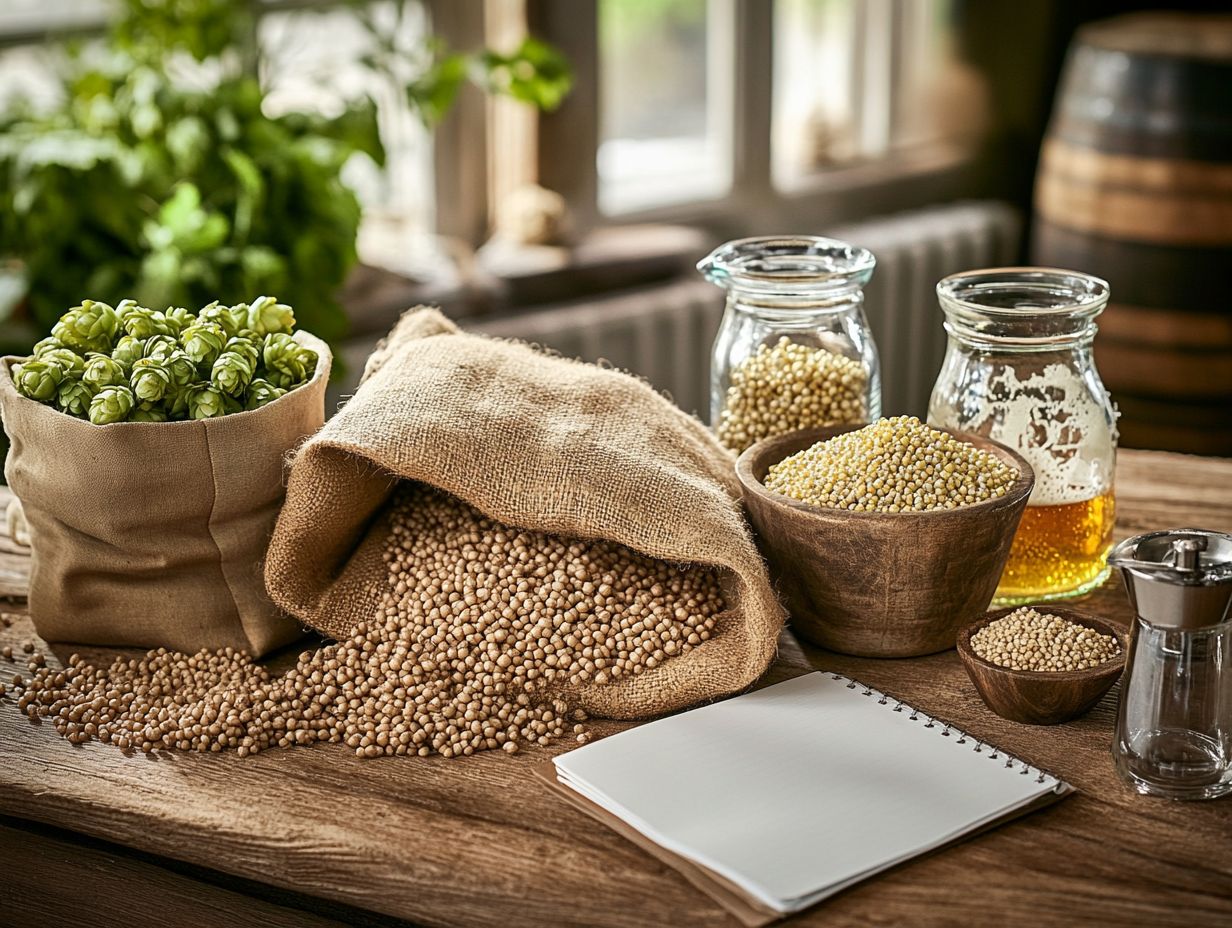
Determining the quality of your beer ingredients is absolutely essential for crafting high-quality craft beer. Using subpar components can lead to flavors and aromas that are anything but desirable in your final product. Quality malt should flaunt the right color and sweetness, while hops need to have that fresh aroma and bitterness appropriate for the style you re aiming to create.
Your yeast strains must be healthy and viable to ensure effective fermentation. Don’t underestimate the importance of pure brewing water; it is crucial for achieving the desired taste and stability, free from any unwanted impurities that could throw a wrench in your brewing process.
To effectively assess your ingredients, employ sensory evaluations, such as smell and taste tests, alongside laboratory analyses to measure specific gravity, which is the density of a liquid compared to water, pH levels indicating acidity or alkalinity, and microbial counts. This combination equips you to ensure that each ingredient meets your brewery’s high standards.
Regarding sourcing, best practices involve establishing strong relationships with suppliers. Act quickly to build these relationships to ensure you re always brewing with the best ingredients available! This not only allows for better transparency regarding ingredient origins and handling practices but also sets the stage for quality assurance. By prioritizing quality control and consistent testing protocols, you can maintain excellence and achieve the flavor profiles you desire in your products, ultimately enhancing the overall brewing experience.
What Are Some Tips for Experimenting with Different Beer Ingredients?
Experimenting with various beer ingredients opens the door to innovative flavor combinations and unique styles that can truly captivate beer enthusiasts and set your microbrewery apart in a competitive market.
Engaging in this creative experimentation not only tantalizes the palate but also ignites inspiration for new brews that resonate with a diverse audience. For example, consider incorporating exotic spices like coriander or hibiscus to give a refreshing twist to traditional wheat beers.
Alternatively, exploring barrel-aging techniques with unique wood types can infuse complex flavors that elevate an already exceptional stout.
Importantly, maintaining a detailed brewing journal allows you to track which ingredient combinations yield the most successful results. This practice fosters consistency and encourages you to build on your past experiments, leading to exciting offerings that distinguish your brewery in a bustling craft beer landscape.
What unique flavors will you explore in your next brew?
How Can One Incorporate Local or Unique Ingredients into Beer?
Incorporating local or unique ingredients into your beer can create distinctive flavors that elevate your craft beer experience, allowing you to tell a captivating story through your creations. By sourcing ingredients from local farms or markets, you can infuse your brews with regional flair think local fruits, spices, or herbs that reflect the rich heritage and environment of your area.
This approach not only supports local agriculture and businesses but also opens the door to a world of creativity in brewing. It enables you to develop exclusive flavor profiles that truly stand out in a crowded market.
Imagine a brewery that uses wildflower honey sourced from nearby hives. This adds a natural sweetness that beautifully complements the beer’s malt profile. When executed skillfully, such unique combinations can yield delightful results, like a luscious peach wheat beer that showcases the juicy bounty of the local harvest.
Of course, breweries face challenges when sourcing these ingredients, such as seasonal availability and the potential variability in quality. This unpredictability can lead to thrilling surprises in your brewing adventures, pushing you to adapt your processes and recipes continuously.
While these challenges exist, they also create a thrilling opportunity for innovation in flavor expression.
What Are the Potential Risks of Using Certain Beer Ingredients?
While experimenting with various beer ingredients can lead to some truly remarkable results, it’s crucial for you to be aware of the potential risks associated with certain components. These risks include contamination during fermentation, which can adversely affect both the flavor and stability of your beer. Additionally, the introduction of non-traditional ingredients might not mesh well with the brewing process.
Some ingredients could even pose health risks or create unwanted flavors if not used judiciously, making it essential for you to thoroughly research and test any new additions to your recipes. For example, using fruits or spices without proper sanitation can result in unpleasant sourness or off-flavors caused by wild yeast or bacteria.
Certain adjuncts may also interact with the yeast in unexpected ways, impacting attenuation the process of how well yeast converts sugars into alcohol and clarity.
To minimize these risks, you can adopt best practices such as:
- Conducting small-scale trials before committing to larger batches,
- Employing rigorous sanitation methods, and
- Monitoring pH levels throughout fermentation.
By remaining vigilant and informed, you can not only safeguard your brewing process but also elevate the quality and uniqueness of your beers.
Learn more about the topic by watching the video above!
Frequently Asked Questions
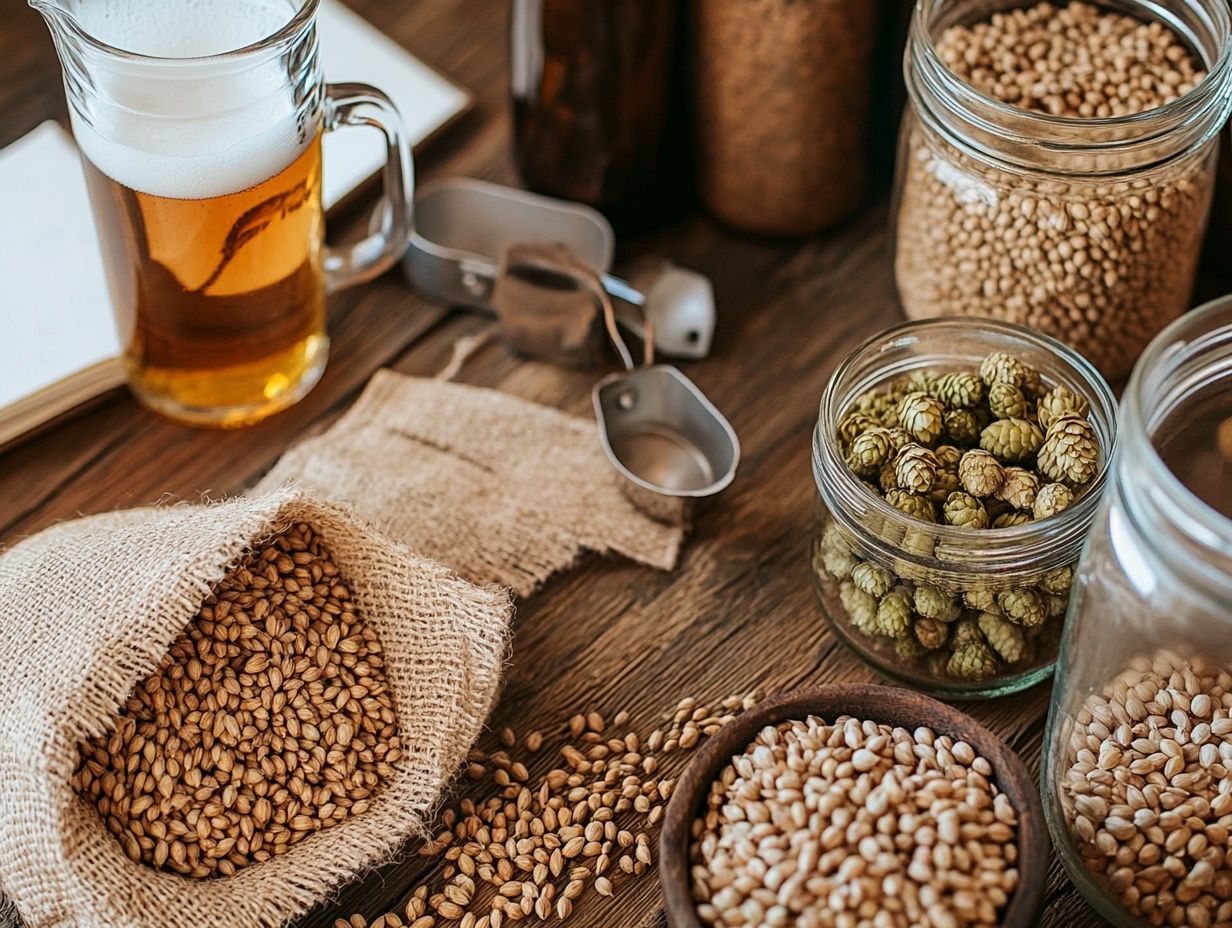
What are the 5 key factors to consider when selecting beer ingredients?
Curious about the essential factors for perfecting your beer? The 5 key factors for selecting beer ingredients are flavor, aroma, color, fermentability, and cost. These factors all play a crucial role in determining the overall taste and quality of the beer.
How does flavor factor into the selection of beer ingredients?
Flavor is arguably the most important factor when selecting beer ingredients. Each ingredient, such as hops, malt, and yeast, contributes its own unique flavor profile to the final product. It’s important to balance these flavors to create a well-rounded and enjoyable beer.
Why is aroma an important consideration in beer ingredient selection?
Aroma is closely tied to flavor and can greatly influence the overall experience of drinking a beer. Certain ingredients, like hops, are known for their distinct aromas and can add depth and complexity to the beer.
How does color affect the selection of beer ingredients?
Color is often associated with the type of beer being brewed and can be altered by the ingredients used. For example, darker malts will result in a darker beer, while lighter malts will produce a lighter color. Brewers must carefully select their ingredients to achieve the desired color for their beer.
Ready to try your hand at brewing with local ingredients? Dive in and unleash your creativity!
Understanding Beer Ingredient Selection
Why is fermentability an important factor?
Fermentability describes how ingredients turn into alcohol during brewing. Some grains ferment better than others.
Choosing the right fermentability level in ingredients is key to crafting the perfect beer!
How does cost play a role?
Cost is crucial when picking beer ingredients. Specialty hops and rare malts can drive up production expenses.
Brewers balance quality and cost to create delicious and affordable beer!

